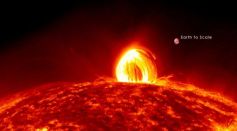Tags: Earth
Magnetosphere Would Probably Not Provide Protection When the Sun Dies, What Would Happen Then?

‘Unusual’ Flu-Like Symptoms: Astronaut Explains Changes in His Body While on Journey Away From Earth
Momentum on Planetary Scale: What Happens When Earth Suddenly Stops Spinning?
Moon-Forming Disc Discovered Around Very Young 5.4 Million-Year-Old Jupiter-Like Exoplanet; Astronomers Consider Their Discovery Important
Earliest Land Plants 400 Million Years Ago Possibly Modified Earth's Climate Regulation
5 Ways of Shark Conservation: NASA's Earth-Observing Satellites Help in Nature Maintenance

Why Is Venus So Bright? Here's How Its Proximity to Earth, Highly Reflected Clouds Affects It
Mars, Venus, Moon Conjunction: Look Up and Catch a Celestial Treat in the Night Sky

Four Newly Discovered Exoplanets Could Give Insights to Earth's Teenage Life

NASA, Purdue Team Fly Miles Above Earth up to 70,000 Feet, to Study Data on North American Monsoon Season
Venus Crust Broken? Large Blocks Moving Like Sea Ice Seen on Planet Showing Proof of Geological Activity

Solar Storm Heading Towards Earth Likely to Hit Soon; How Does It Affect Someone's Health?

Winchcombe Meteorite Officially Classified as 'Extremely Rare Space Rock' Worth Almost $140,000
Exoplanets With "Goldilocks Zone" Could Host Life, NASA Suggests
'Finding Prospero': Skyrora Launches Challenge to Find the Best Way to Retrieve This 1st and Only UK Spacecraft
Caltech: Rare Type of Stellar Grain Discovered, Scientists Explain More About Water’s Origin on Earth

Largest X-Class Solar Flare: Why It is Impossible for "Killer Solar Flare" to Destroy Earth
2.7-Billion-Year-Old Diamonds Proves That Life-Giving Elements Appeared Shortly After Earth Was Formed
Aphelion 2021: What to Expect When Earth Is at Its Furthest from the Sun

Earth's Cryosphere Shrinking by 33,000 Square Miles Annually: How Does Ice Sheet Melting Impact the Planet?
Most Popular

Viruses vs Bacteria: Key Differences, How They Spread, and How We Treat Them

How Ice Cores Reveal Climate History: Insights from Paleoclimate Science and Ancient Data

Science-Backed Longevity Supplements: The Best Anti-Aging Vitamins for Powerful Healthy Aging Support

Carbon Footprint 101: What It Is and Simple Ways to Reduce Yours




